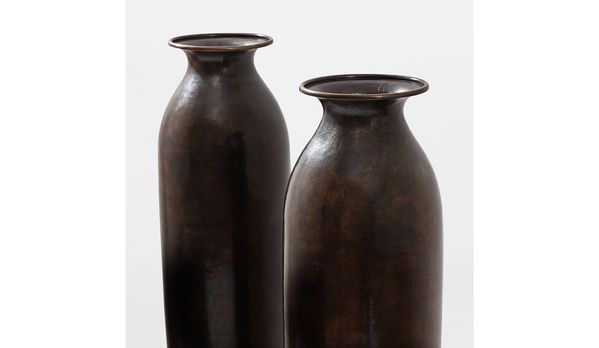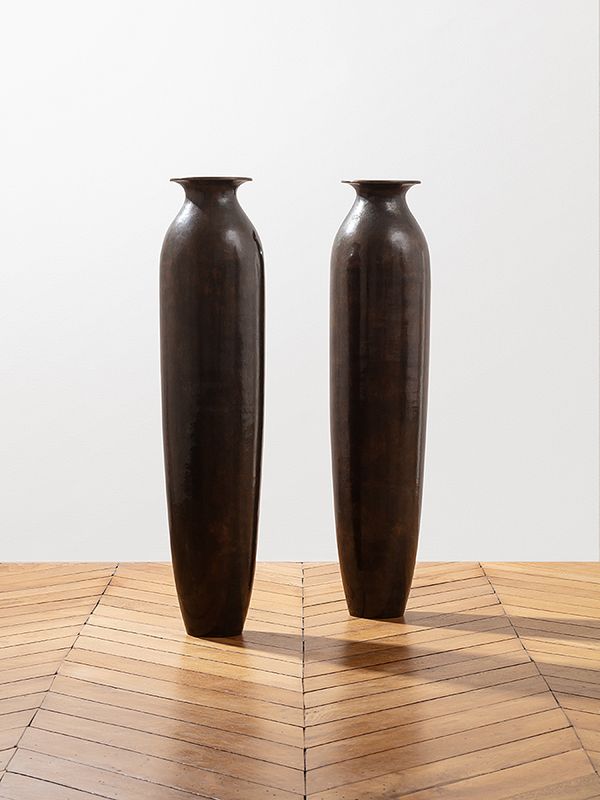Jean Dunand, Pair of monumental vases, circa 1913. Design New York.
By Amélie Marcilhac, author of Jean Dunand (2021)
At the age of just nineteen, Jean Dunand (1877-1942) began garnering attention in the Swiss art scene. Thanks to the sale of figurative sculptures that he had created in 1896, he succeeded in winning a scholarship from the city of Geneva which allowed him to study sculpture under Jean Dampt at the École National des arts décoratifs in Paris. With this training, he won a gold medal at the 1900 Exposition Universelle de Paris for his work Quo Vadis and beginning in 1902 his sculptures entered the collections of Swiss museums. Despite such encouraging beginnings, Dunand soon realized that the medium of the sculptor did not suit him and that gaining notoriety as an artist required innovation. He therefore decided, while continuing to present his sculptures at the Paris salons, to exhibit his works in dinanderie, a technique he had learned at the end of the 1890s from Auguste Dannhauer, a Genevese coppersmith. Encouraged by the public’s interest in these works at the 1904 Salon de la Société Nationale des Beaux-Arts, Dunand decided to abandon sculpture, resolutely turning his attention to the decorative arts, encouraged by his mentor Jean Dampt who always contended that an artist must above all be a craftsman. His vases, boxes and coupes were unanimously praised by the critics and one of his gold-inlaid vases was even acquired by the Union centrale des arts décoratifs de Paris in 1905.
Jean Dunand in his atelier, circa 1918.
Refusing the use of machines to give form to his creations, Dunand used a boxwood mallet to raise sheets of copper, brass, or maillechort from the interior. From a flat sheet, he succeeded in arriving at forms in high relief, entirely hammered in small successive blows like a sculptor, in order to achieve the shape of the desired object. In the beginning, he created simple forms that allowed him to highlight his technique, torch-fired patinas, and precious-metal inlays. The pair of vases on offer in this sale falls perfectly into this category. Created in maillechort, an alloy of nickel, copper, and zinc, they are remarkable for their size as well as for the technical skill Dunand deployed to arrive at their elegantly attenuated oval forms graced at the rim with a brass lip.
With him, there were no sudden, passing interests, but rather a slow, inwards cultivation of beauty.
—Bernard Dunand on his father, Jean Dunand
Every centimeter of the vases is covered in a number of delicate hand-hammered marks which, taken as a whole, subtly bring the surface of each vessel to life. The form of these vases, inspired by ancient amphorae, would become a trademark throughout his career, executed in varying dimensions, inlaid with decoration, beautifully patinated or entirely lacquered. What sets the present vases apart in particular is their extraordinary height, standing 37 inches (94 cm) tall. In order to achieve such a tall yet lean stature, Dunand folded the metal sheet, expertly joining the sides with a seam running up the height of each vase. He then hammered the sheet at the location of the seam to ensure an even thickness and texture. Dunand developed this technique for his monumental vases, and while it is rarely seen, here we find it perfectly executed on both vases, augmented by a rich brownish-black torch-fired patina.
The present vases exhibited in Phillips’ gallery in Paris.
Dunand also chose not to set these important vases in a tripod stand, as he did for many of his other works that measured over 27 ½ inches (70 cm) in height, thus reinforcing their resemblance to ancient amphorae. These vases exist on their own, by simply being placed on the ground and deploying all the technical skills of their maker who signed them not only with his full name, but with his goldsmith’s mark, in keeping with a large part of his creations from the early 1910s. While the original owner and exhibition history remain unknown, they would have made a powerful display at the entrance to one of the many salons he participated in, or in the home of one of his top patrons of the era.
Recommended Reading
Rembrandt, the Other Bugatti >


